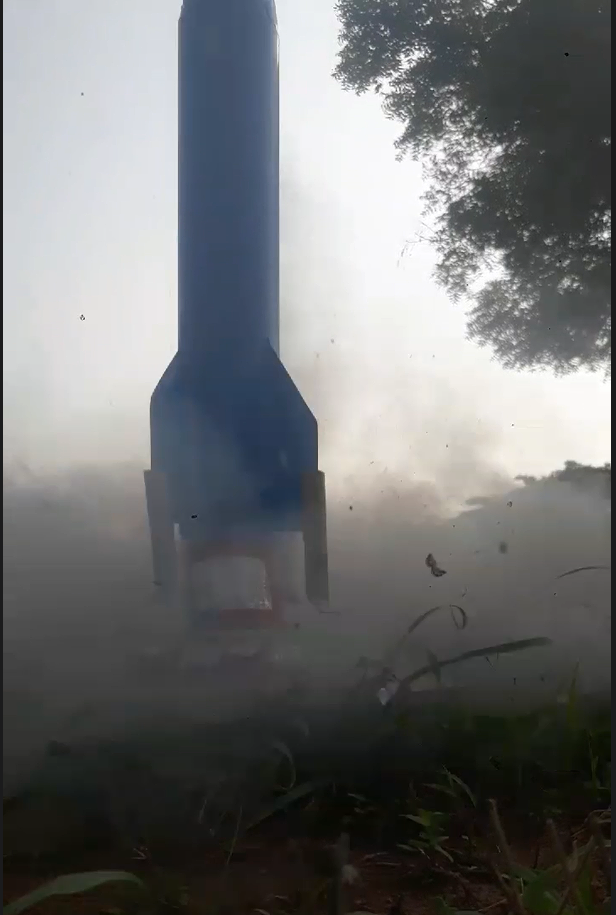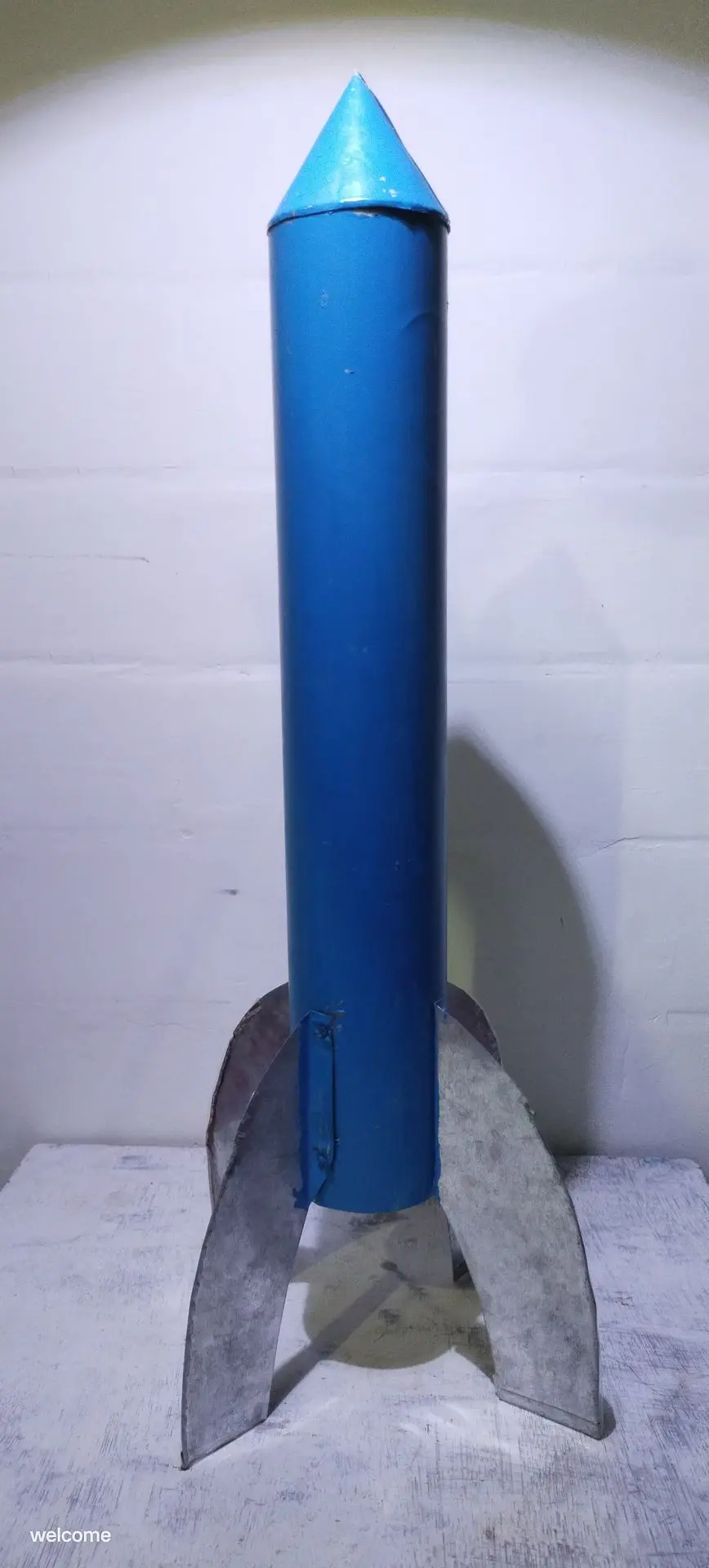

MARK-1 PROFILE
Objective of the Rocket:
The primary objective of this rocket is to assess atmospheric conditions by analyzing gases and calculating air quality. Specific goals include:
- Cost-effective design for broader accessibility
- Integration of innovative ideas contributed by students
- Promoting awareness of rocketry, its scientific principles, and its technological applications
- Encouraging skill development in the creation of scientific projects, fostering the next generation of engineers and researchers
Key Physics Laws in Rocketry:
Newton’s First Law of Motion (Inertia):
An object will continue in a state of rest or uniform motion unless an external force acts upon it. This principle is fundamental in understanding how rockets maintain stability and trajectory.
Newton’s Second Law of Motion (Force and Acceleration):
The acceleration of an object is directly proportional to the applied force and inversely proportional to its mass. The equation:
F = ma (Force = mass × acceleration).
This law governs the acceleration of the rocket due to the force generated by the propulsion system.
Newton’s Third Law of Motion (Action and Reaction):
For every action, there is an equal and opposite reaction. In rocketry, the expulsion of propellant gases results in a thrust force that propels the rocket upwards.
Conclusion:
Newton's laws form the foundation of rocketry. However, practical implementation involves applying these laws effectively through engineering considerations such as:
- Determining the required thrust-to-weight ratio for the rocket to lift off
- Choosing the right materials for structural integrity and efficiency
- Calculating optimal rocket size, propulsion system, and mass distribution
- Ensuring flight control, navigation, and safe landing mechanisms
Types of Rocket Engines:
Liquid Propulsion:
Liquid-fuel engines offer high specific impulse (Isp) and efficiency due to the high energy density of liquid propellants. These engines allow for variable thrust and are commonly used in upper stages of rockets for precise maneuvering and extended flight durations. Key features include:
- Advantages: High energy density, adjustable thrust, better performance at high altitudes
- Disadvantages: Complex plumbing, requires cryogenic fuels or high-pressurization systems
Solid Propulsion:
Solid engines provide a high thrust-to-weight ratio, making them ideal for booster stages. They are simpler in design and can operate under extreme conditions, though they lack the precision control of liquid engines. Solid-fuel rockets are often used in launch boosters and initial propulsion stages.
- Advantages: Simple design, reliable, cost-effective
- Disadvantages: Less controllable, fixed thrust levels
Physical Specifications of the Mark-1 Rocket:
Rocket Profile:
- Length: 50 cm (19.7 inches)
- Diameter: 8 cm (3.1 inches)
- Weight: 1 kg (2.2 lbs)
Propulsion:
- Type: Solid fuel
- Thrust: 8 lbs (35.7 N)
Materials:
- Body: Aircraft-grade aluminum alloy for structural integrity and weight reduction
- Fins: Reinforced recycled thermoplastic polymers for aerodynamic stability
Communication System:
- Type: Real-time radio communication with ground control and other rocket stages
Performance Parameters:
- Estimated altitude: 3-5 km (10,000-16,400 feet)
- Max speed: 10 m/s (22.4 mph)
Background:
- A project driven by personal interest, aiming to push the boundaries of amateur rocketry and technology.
Goals:
- To create the smallest high-tech, reusable rocket capable of exceeding traditional limitations in rocketry.
Future Development Plans:
- Refinement of the Mark-1’s design, including improvements in propulsion, payload capacity, and onboard systems.
- Advancement towards universal space exploration using small-scale, high-tech rockets.
Innovative Features:
- Modular design: Allows for easy upgrades and changes to components based on future requirements
- Tech Turf onboard guidance system: GPS, accelerometers, and gyroscopic sensors for enhanced navigation and stability
- Autonomous systems: The rocket’s onboard AI enables autonomous decision-making during flight for maximum safety and efficiency.
Potential Applications:
- Aerospace research: Testing new propulsion systems, materials, and payloads
- Space exploration: Low-cost platform for launching miniaturized payloads into low-Earth orbit (LEO)
- Military technology: Advanced guidance and control systems for strategic applications
Stage 1: Booster Module
- Fuel: A high-energy solid propellant is utilized to overcome the Earth's gravity and push the rocket through the atmosphere.
- Control Unit: The onboard flight computer ensures stability and provides telemetry to the ground station, enabling real-time monitoring.
- Separator: A mechanical separation system that disengages Stage 1 from Stage 2, using an explosive charge or pyrotechnic device to create a clean stage separation.
Stage 2: Mark-1 Rocket
- Fuel: Solid propellant, optimized for high efficiency and thrust to achieve further altitude.
- Control Unit (Tech Turf Onboard Computer - TTOBC): A high-performance embedded system using a microcontroller or FPGA to handle all rocket functions, including navigation, stabilization, and communications across both stages.
- Communication Unit (TTOBC): Dual communication channels for redundancy, including RF, Wi-Fi, and Bluetooth, ensuring seamless data transfer with the ground station and between stages.
- Storage: TTOBC features 32GB RAM and 8GB ROM to store mission-critical data such as sensor readings, telemetry, and control algorithms.
- Data Communication Speed:
- Wired: Using USB Type-C or Ethernet for fast, high-bandwidth data transfer
- Wireless: Real-time data streaming via Wi-Fi (5 Mbps), Bluetooth 5.4 (up to 5 meters), or long-range radio communication (up to 250 bps at maximum range).
- Separator: A pyrotechnic device or mechanical actuator that cleanly separates the two stages, ensuring smooth progression to Stage 2.
Uses of the Mark-1 Rocket:
The Mark-1 rocket serves as an experimental testbed for new technologies and as a proof of concept for the smallest, most efficient rockets in the world. With advanced features, the rocket is capable of:
- Autonomous decision-making: The onboard computer can adapt to changing conditions and make adjustments to maintain optimal performance.
- Reusability: The rocket is designed to return to its launch site after completing its mission, using autonomous landing capabilities.
- Weather detection and monitoring: Equipped with advanced environmental sensors, the rocket can assess atmospheric parameters such as temperature, humidity, air quality, and wind speed.
- Advanced imaging: Onboard cameras with high-definition capabilities allow for both live streaming and post-flight image capture.
- AI-powered data analysis: A miniaturized artificial intelligence system analyzes collected data for deeper insights and optimizes rocket performance.
The Mark-1 is an advanced, cutting-edge rocketry system that combines innovative engineering with practical applications for aerospace, meteorology, and future space exploration missions.

